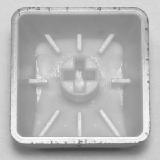Replacement Keycaps for Eos Family Consoles
This article is a list of currently available replacement keycap sets. For a general overview of different types of keycaps that have been used on Eos Family consoles, see this article.
For Eos Ti and Gio consoles and Programming Wings, replacement kits differ depending on the style of keyboard on your console (Cherry or AIS). To check which style of keyboard you have, see this section below.
Full Keycap Sets
| Console | Part Number | Keys | Keys Included | Image |
|---|---|---|---|---|
| Ion Xe and Ion Xe 20 Gio @5 Gio* Programming Wing* * with Cherry keyboard only |
4390K1020 | 88 | All main keyboard keys does not include [Stop|Back], [Go], and [Master] keys does not include fader bump keys |
 |
| Element 2 | 4331K1020 | 88 | All main keyboard keys does not include [Stop|Back], [Go], and [Master] keys |
 |
| Eos Ti* * with Cherry keyboard only |
4350K1020 | 88 | All main keyboard keys does not include [Stop|Back], [Go], and [Master] keys |
 |
| Ion | 4310K1110 | 89 | All keys |  |
| Element | 4330K1106 | 79 | All keys |  |
| Eos Classic | 4250K1131 | 80 | All keys |  |
Partial Keycap Sets
| Console | Part Number | Keys | Keys Included | Image |
|---|---|---|---|---|
| Apex consoles Ion Xe and Ion Xe 20 Gio @5 Gio* Eos Ti* Programming Wing* * with Cherry keyboard only |
4450K1103 | 18 |
|
 |
| Element 2 | 4331K1003 | 18 |
|
 |
| Apex consoles Ion Xe and Ion Xe 20 Gio @5 Element 2 Gio* Eos Ti* Programming Wing* with Cherry keyboard only |
4450K1105 | 2 |
|
 |
AIS Keyboard Retrofit Kits
| Console | Part Number | Keys | Parts Included | Image |
|---|---|---|---|---|
| Gio† Programming Wing† † with AIS keyboard only |
4240K1011 | 88 |
|
 |
| Gio† † with AIS keyboard only |
4240K1012 | 33 |
|
 |
| Eos Ti† † with AIS keyboard only |
4350K1008 | 88 |
|
 |
| Eos Ti† † with AIS keyboard only |
4350K1009 | 33 |
|
 |



